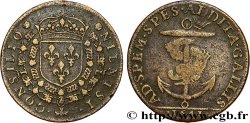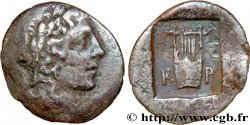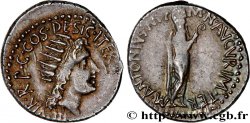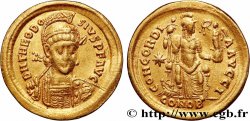v11_0874 - CONSEIL DU ROI Henri III 1575
MONNAIES 11 (2002)
起拍价 : 121.96 €
估价 : 304.90 €
竞价记录 : 229.89 €
出价数量 : 2
最高出价 : 335.39 €
起拍价 : 121.96 €
估价 : 304.90 €
竞价记录 : 229.89 €
出价数量 : 2
最高出价 : 335.39 €
种类 Henri III
日期: 1575
材质 silver
直径 28 mm
模子方针 6 h.
重量 4,52 g.
侧面 lisse
稀少度 R3
关于品相的说明
Ce jeton est frappé sur un flan large et régulier ; il présente une patine grise. On doit noter une faiblesse de frappe sur le haut de l’écu de France et une rayure au-dessus de l’éléphant
出版目录中的项代码 :
正面
正面的文字 (ROSETTE) NIL. NISI / CONSILIO (ROSETTE).
正面的说明书 Écu de France couronné et entouré du collier de l’ordre de Saint-Michel dont le bijou coupe la légende à 6 heures.
正面的翻译 (Rien sans le Conseil).
背面
背面的文字 (ROSETTE) PLACIDIS PARCIT..
背面的说明书 Un éléphant avançant à gauche, un serpent sous ses pattes arrières, des moutons en arrière plan devant lui ; à l’exergue, 1575.
评论
On note au droit deux rosettes à quatre pétales tandis qu’au début de la légende du revers il s’agit d’une rosette à six pétales, creuse en son centre.
Le revers de ce jeton ne semble répertorié dans aucun des ouvrages de référence. Il est pourtant connu par une reproduction dans l’ouvrage de Jacques de Bie, Histoire de la France métallique, Paris, 1636, pl.74. Cet ouvrage est souvent jugé peu sûr car de nombreuses gravures semblent n’avoir existé que dans l’imagination de De Bie, ce qui est probable, mais ce jeton est la preuve que certains jetons reproduits dans De Bie et actuellement non signalés peuvent encore être retrouvés. Voici ce que dit De Bie de ce revers : “Le Corps est d’un éléphant passant par une campagne, où trouvant des moutons en son chemin il revolte sa trompe vers son front, pour marquer qu’il n’a aucune intention de leur nuire : Et au contraire, marche d’un pied sur un serpent, qui semble s’estre glissé sous son ventre pour luy nuire. Sous l’exergue : MDLXXV. Pour marquer de la clémence du monarque exercée envers ceux de ses subjects, qui demeuroient dans leur devoir ; & de sa sévérité contre ceux qui se rendoient rebelles à ses commandements”. Ce jeton est inspiré d’un denier de Jules César.
Le revers de ce jeton ne semble répertorié dans aucun des ouvrages de référence. Il est pourtant connu par une reproduction dans l’ouvrage de Jacques de Bie, Histoire de la France métallique, Paris, 1636, pl.74. Cet ouvrage est souvent jugé peu sûr car de nombreuses gravures semblent n’avoir existé que dans l’imagination de De Bie, ce qui est probable, mais ce jeton est la preuve que certains jetons reproduits dans De Bie et actuellement non signalés peuvent encore être retrouvés. Voici ce que dit De Bie de ce revers : “Le Corps est d’un éléphant passant par une campagne, où trouvant des moutons en son chemin il revolte sa trompe vers son front, pour marquer qu’il n’a aucune intention de leur nuire : Et au contraire, marche d’un pied sur un serpent, qui semble s’estre glissé sous son ventre pour luy nuire. Sous l’exergue : MDLXXV. Pour marquer de la clémence du monarque exercée envers ceux de ses subjects, qui demeuroient dans leur devoir ; & de sa sévérité contre ceux qui se rendoient rebelles à ses commandements”. Ce jeton est inspiré d’un denier de Jules César.







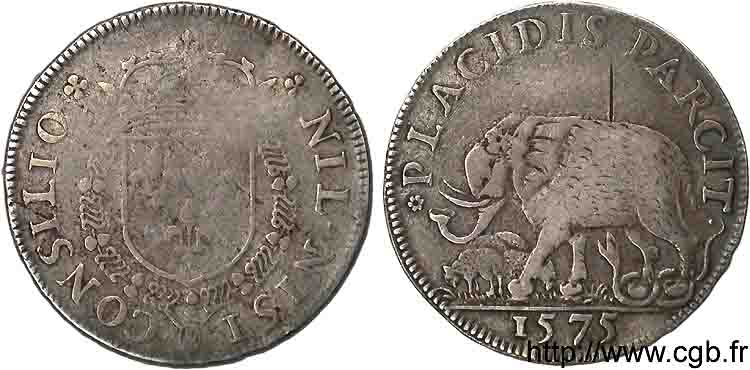
 对产品描述纠错
对产品描述纠错 打印
打印 分享我的选择
分享我的选择 提问
提问 Consign / sell
Consign / sell
 产品介绍
产品介绍



